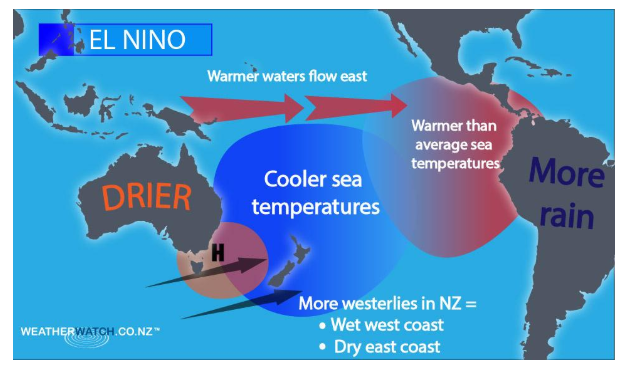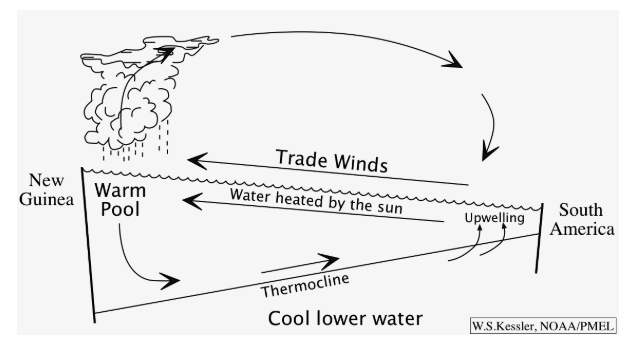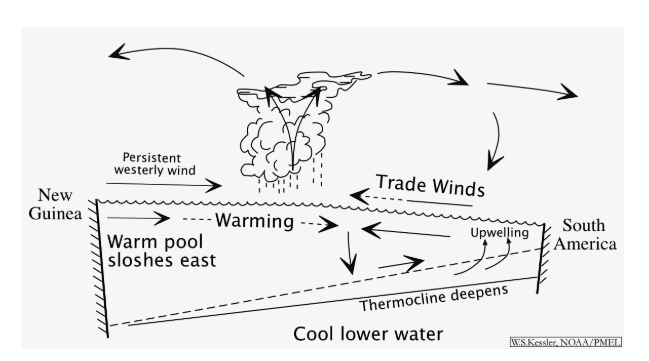El Nino Effect
Archives
TOPIC: General Studies 3
- Conservation, Climate change
El Nino is the name given to a slight warming of the surface waters of the Pacific. It is opposite of La Nina, which is a cooling. As the ocean is one of the biggest influences in our weather, both of the phenomena have a dramatic effect on the weather around the globe.
Collectively, El Niño and La Niña are parts of an oscillation in the ocean-atmosphere system called the El Niño-Southern Oscillation, or ENSO cycle, which also has a neutral phase.
El Nino was discovered far earlier than La Nino, as it had a direct impact on the Peruvian fishermen. They noticed that every three to seven years, in the months of December and January, there would be virtually no fish in the seas. As it was noticed around Christmas time, they named this phenomenon El Nino (Spanish for ‘the baby boy’).

What happens ‘normally’, at a time when there is no El Nino or La Nina?
- The warmest part of the Pacific Ocean is the region near the equator. Due to the spinning of the earth, the prevailing winds flow from east to west. This pushes the warm waters westwards, towards Indonesia.
- In the east, around the coast of South America, cool waters would normally well up. These waters are rich in nutrients and fish, and provide plenty of food for the Peruvian Fisherman.
- During a normal year it’s cool and not too rainy along the western coast of the Americas, and warm and wet in the western part of the Pacific.

During an El Nino event:
But when the trade winds die, two things happen:
- The wind-forced upwelling that draws cool water to the surface slows down, and the warm water that has pooled up in the western part of the Pacific basin starts to slosh back toward the east. And as the warmth spreads eastward, the trade winds—which are partly controlled by the temperature and air pressure differences between the two sides of the Pacific—get even weaker.
- So the chilly waters that usually help cool down the South American coast stay trapped deep below the surface, and the winds that would help cool things down stagnate. The prevailing winds across the Pacific weaken, and sometimes they can even reverse and blow the other way. This allows some of the warmer waters to move eastwards, away from Indonesia and towards South America.
Easy to explain events:
- The location of tropical storms shifts eastward during an El Niño because atmospheric moisture is fuel for thunderstorms, and the greatest amount of evaporation takes place above the ocean's warmest water.
- Waters near the coast of South America are warmer than usual, which makes the weather in the region warmer than usual. This increases evaporation and therefore the region also sees more rain than in a typical year.
- Because the warmer waters are moving away from Indonesia, the weather here is drier than usual.

Difficult events for some:
- Usually decreases the hurricane activity in the Atlantic
- Higher global temperatures: During an El Niño, the warmer tropical waters in the Pacific can transfer their energy to the atmosphere. When combined with man-made global warming, this can push global average surface temperatures to new highs.
- In 2016, Corals, which aren’t great at dealing with either extreme heat or extreme cold, languished in the tepid waters. Stressed by the heat, they started to sicken and bleach, and in some cases die. By the end of the season, vast swaths of the Pacific’s reefs were bleached bone white.
- The strongest El Niño event that has ever been recorded occurred in 1997- 1998. Its impact was felt in many parts of the world. Droughts hit Indonesia and other islands in the western Pacific, triggering uncontrollable forest fires. Peru suffered deadly flooding. Record-breaking rainfall hit the US state of California, causing mudslides and flooding. Kenya too, was hit by severe flooding.
- El Nino decreases earth’s rotation rate, the Coriolis force and increases the length of day. (La Nina creates opposite): As it changes the wind pattern, Earth needs a change in speed to conserve its angular momentum of Earth-Atmospheric system.
- The weak push to Monsoon winds towards India leads to less rainfall or weak monsoon.
- Rise in prices of commodities (sugar, pulses and edible oil) which leads Government to stock them up and put restriction on exports to avoid the hoarding via black market.
- This is the case especially in the western regions as the cost of raw materials increases hurting the manufacturing sector.
- Farmers suffer the most as they have to work on their strategy depending on the drought like situation.
Connecting the Dots:
- What do you understand by an El Nino year? Also explain the mechanism of its occurrence. How does it affect the Indian subcontinent?
- What is La-Nina? Examine its effects on India’s climate.
